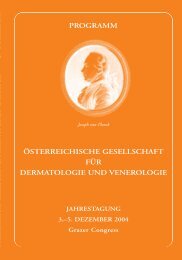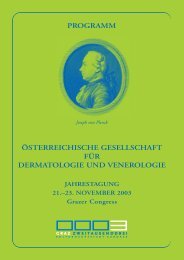PROGRAMM JAHRESTAGUNG 2012 30. Nov. – 2. Dez ... - ÖGDV
PROGRAMM JAHRESTAGUNG 2012 30. Nov. – 2. Dez ... - ÖGDV
PROGRAMM JAHRESTAGUNG 2012 30. Nov. – 2. Dez ... - ÖGDV
Sie wollen auch ein ePaper? Erhöhen Sie die Reichweite Ihrer Titel.
YUMPU macht aus Druck-PDFs automatisch weboptimierte ePaper, die Google liebt.
Poster Infektionen der Haut<br />
P 27<br />
Identification of HPV vaccine-genotypes in a female STI population group<br />
Natalie Isabella Hartl 1<br />
Claudia Heller-Vitouch 1<br />
Angelika Stary 1<br />
1 Outpatients Centre for STD Diagnosis, Vienna, Austria<br />
Background and Objectives: Women harbouring HPV genotypes are at risk to develop<br />
either genital warts or cervical dysplasia as a precursor of cervical carcinoma. Aim of<br />
the study was to evaluate the prevalence of HPV vaccine-genotypes in a symptomatic<br />
and asympytomatic female population group. Furthermore, an age-related distribution<br />
of different genotypes was investigated for different clinical syndromes.<br />
Materials and Methods: Data were collected from 4230 patients between February<br />
and July <strong>2012</strong>. Material was either delivered or sent to the Outpatients Centre laboratory<br />
or sampled and processed at the Outpatients Centre. Clinical diagnosis was assessed<br />
by the referring physician. Samples were collected either from the cervical area or from<br />
genital lesions by Cytobrush DNAPAP Cervical Sampler. Viral DNA detection and HPV<br />
genotyping was performed using Papillo Check PCR. Data from women with the diagnosis<br />
of cervical dysplasia and cervical cancer precursors including PAP III, IIID, IV and<br />
CIN I, II, III (n= 1485) and genital warts, respectively, were included. Additionally, data<br />
were evaluated according to age groups of women from 20 to 30 and 50 to 60 years.<br />
Results: Out of all 1485 patients with cervical dysplasia and cervical cancer precursors<br />
55,2% were HPV high-risk positive. In 29.5% infection with HPV 16, and in 6.1%, respectively,<br />
HPV 18 could be detected. Furthermore, referring to vaccination cross immunity<br />
HPV 31, 33, 45, and 52 were detected in 14,9% 7,7% , 2,9% and 6,2% respectively. When<br />
focusing on the younger age group, 3<strong>2.</strong>9% of all high risk positive patients with cervical<br />
dysplasia and cervical cancer precursors turned out to be positive for HPV 16, and 7.8%<br />
for HPV 18. Other frequently detected HPV high-risk types in this age group were HPV<br />
31 (14%), HPV 45 (1,9%), HPV 51 (19,2%) and HPV 56 (9,3%). In contrast to these results,<br />
in women between 50 and 60 years of age with cervical dysplasia and cervical cancer<br />
precursors an infection with HPV 16 was detected only in 20%, with HPV 18 in 4% and<br />
with HPV 45 in 6%, respectively. In addition, HPV 51 was detected in 12% and HPV 56<br />
in 18%. The identification of genotypes evaluated for different age groups shows that<br />
both strains, HPV 16 and 18, were more often detected in young women and decreased<br />
with increasing age. In contrast, an increase of HPV high-risk types other than 16 and<br />
18, such as HPV 45 and 56, were more often identified in older women. In the group of<br />
individuals with genital warts (n=558), HPV-low-risk types were detected in 4<strong>2.</strong>8%. The<br />
genotyping showed a higher detection rate of HPV 6 (60,7%) compared with HPV 11 (10.5%).<br />
Conclusion: A high number of the HPV high-risk types 16 and 18 was detected<br />
especially in the group of young women compared with women in the higher age<br />
74









